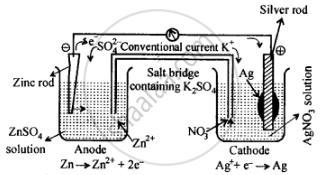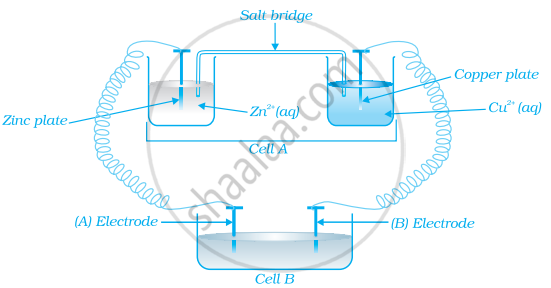Advertisements
Advertisements
प्रश्न
Depict the galvanic cell in which the reaction \[\ce{Zn(s) + 2Ag+(aq) → Zn^{2+}(aq) + 2Ag(s)}\] takes place. Further show:
- Which of the electrode is negatively charged?
- The carriers of the current in the cell.
- Individual reaction at each electrode.
उत्तर
The set-up will be similar to as shown below:

The cell will be represented as:
\[\ce{Zn(s) | Zn^{2+}(aq) || Ag^+(aq) | Ag(s)}\]
- Anode, i.e., zinc electrode, will be negatively charged.
- The current will flow from silver to zinc in the external circuit.
- At anode: \[\ce{Zn(s) -> Zn^{2+}(aq) + 2e–}\]
At cathode: \[\ce{Ag+(aq) + e– -> Ag(s)}\]
APPEARS IN
संबंधित प्रश्न
Arrange the following reducing agents in the order of increasing strength under standard state conditions. Justify the answer
|
Element |
Al(s) |
Cu(s) |
Cl(aq) |
Ni(s) |
|
Eo |
-1.66V |
0.34V |
1.36V |
-0.26V |
Calculate Ecell and ΔG for the following at 28°C :
Mg(s) + Sn2+( 0.04M ) → Mg2+( 0.06M ) + Sn(s)
E°cell = 2.23V. Is the reaction spontaneous ?
Can copper sulphate solution be stored in an iron vessel? Explain.
The standard e.m.f of the following cell is 0.463 V
`Cu|Cu_(1m)^(++)`
What is the standard potential of Cu electrode?
(A) 1.137 V
(B) 0.337 V
(C) 0.463 V
(D) - 0.463 V
Calculate E°cell for the following reaction at 298 K:
2Al(s) + 3Cu+2(0.01M) → 2Al+3(0.01M) + 3Cu(s)
Given: Ecell = 1.98V
Calculate emf of the following cell at 25 °C :
Fe|Fe2+(0.001 M)| |H+(0.01 M)|H2(g) (1 bar)|Pt (s)
E°(Fe2+| Fe)= −0.44 V E°(H+ | H2) = 0.00 V
Given the standard electrode potentials,
\[\ce{K+/K}\] = −2.93 V, \[\ce{Ag+/Ag}\] = 0.80 V,
\[\ce{Hg^{2+}/Hg}\] = 0.79 V
\[\ce{Mg^{2+}/Mg}\] = −2.37 V, \[\ce{Cr^{3+}/Cr}\] = −0.74 V
Arrange these metals in their increasing order of reducing power.
In the representation of the galvanic cell, the ions in the same phase are separated by a _______.
Calculate the emf of the following cell at 25°C :
The difference between the electrode potentials of two electrodes when no current is drawn through the cell is called ______.
The positive value of the standard electrode potential of Cu2+/Cu indicates that:
(i) this redox couple is a stronger reducing agent than the H+/H2 couple.
(ii) this redox couple is a stronger oxidising agent than H+/H2 .
(iii) Cu can displace H2 from acid.
(iv) Cu cannot displace H2 from acid.
Which reference electrode is used to measure the electrode potential of other electrodes?
Assertion: Cu is less reactive than hydrogen.
Reason: `E_((Cu^(2+))/(Cu))^Θ` is negative.
Consider the figure and answer the following question.
If cell ‘A’ has ECell = 0.5V and cell ‘B’ has ECell = 1.1V then what will be the reactions at anode and cathode?
Which is the correct order of second ionization potential of C, N, O and F in the following?
The emf of a galvanic cell, with electrode potential of Zn2+ = - 0.76 V and that of Cu2+ = 0.34 V, is ______.
A voltaic cell is made by connecting two half cells represented by half equations below:
\[\ce{Sn^{2+}_{ (aq)} + 2e^- -> Sn_{(s)}}\], E0 = − 0.14 V
\[\ce{Fe^{3+}_{ (aq)} + e^- -> Fe^{2+}_{ (aq)}}\], E0 = + 0.77 V
Which statement is correct about this voltaic cell?
